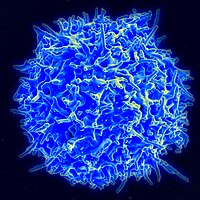
Photo from wikipedia
Background It is incompletely understood which populations of tumor-infiltrating lymphocytes (TIL) respond to checkpoint blockade (CB) and when. Recent studies in murine MC-38 colon carcinoma demonstrate CD4+ T cells are… Click to show full abstract
Background It is incompletely understood which populations of tumor-infiltrating lymphocytes (TIL) respond to checkpoint blockade (CB) and when. Recent studies in murine MC-38 colon carcinoma demonstrate CD4+ T cells are among the most prominent responders,1 but these studies were undertaken late in tumor growth, weeks after CB blockade was initiated. Here, we profile how the landscape of CB-responding TIL change between early and late MC-38 tumor growth, and uncover a novel switch that occurs between natural killer T (NKT) and conventional CD4/CD8 T cell responses. Methods We treated C57BL/6 mice bearing subcutaneous MC-38 tumors with anti-PD-1 and/or anti-CTLA-4 antibodies, and analyzed TIL 11 or 21 days later using a 23-paramter flow cytometry panel that includes three markers of effector function: TNF-alpha, IFN-gamma, and CD107a. We then investigated major populations, including NKT TIL, in ex vivo cytotoxicity assays and in vivo tumor growth studies using CD1d overexpressin MC-38 cells. Results Our analysis identified 37 TIL populations in MC-38 tumors, representing CD4+ or CD8+ T cells, natural killer (NK), and NKT cells. The distribution and effector function among TIL shift dramatically between early and late MC-38 growth. At 11 days, the immune response is dominated by TNF-alpha-producing NKT, which represent 53.5 ± 3.7% of all TIL. These are accompanied by modest frequencies of CD4+ and CD8+ TIL, producing low levels of IFN-gamma. After 21 days, NKT populations are reduced to 15.2 ± 1.5%, giving way to increased NK, CD4+, and CD8+ TIL, with increased IFN-gamma production. CB hastens this switch, markedly reducing NKT to less than 20% of all TIL, downregulating TNF-alpha production across NKT and CD4+ T cell subpopulations, increasing CD4+ and CD8+ TIL frequencies, and significantly up-regulating IFN-gamma production at 11 days. CD107a expression patterns suggest degranulation is most associated with NK and NKT TIL (figure 1). NKT displayed no CD1d-restricted cytotoxicity against MC-38 ex vivo. However, CD1d overexpression on MC-38 significantly delayed tumor growth in vivo, suggesting early NKT activity may indirectly suppress tumor progression, but by what precise mechanism(s) is currently unknown. Conclusions Despite evidence of an indirect benefit of early NKT activity, CB hastens a switch from TNF-alpha-driven NKT involvement toward a IFN-gamma-driven CD4+ and CD8+ T cell response in subcutaneous MC-38 tumors. These results corroborate earlier findings that CD4+ TIL are a major CB-responding population, and introduce a NKT/T cell switch that may be a key feature of the CB response in certain tumors. Ethics Approval Animal experiments in this study were performed according to protocols approved by the University of South Florida’s institutional animal care and use committee (IACUC) committee, number R IS00005710. Reference Wei S, Levine J, Coghill A, Zhao Y, Anang N, Andrews M, Sharma P, Wang J, Wargo J, Pe’er D, Allison J. Distinct cellular mechanisms underlie anti-CTLA-4 and anti-PD-1 checkpoint blockade. Cell 2017 Sep 7; 170(6): 1120–1133.e17.